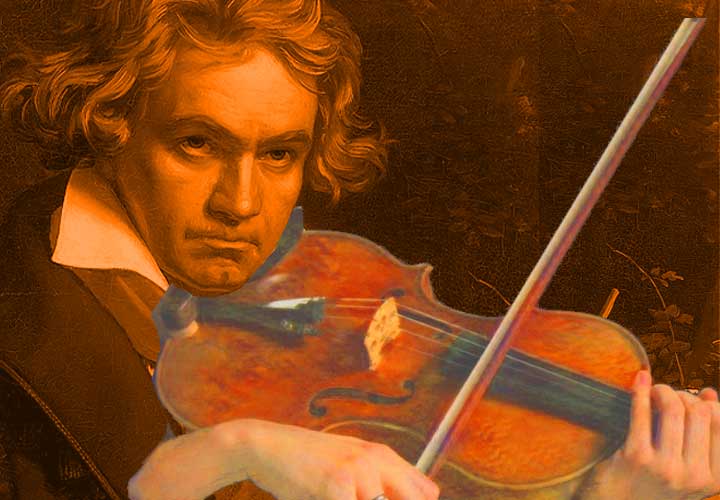A Very Quick Guide To . . . The Viola
February 11, 2023 |
Author: Gavin Thomas |
Category: Instruments |
Very Quick Guide

Beethoven playing the Viola
What’s it all about?
The
viola. The neglected alto of the
string family. Always the bridesmaid, hardly ever the bride.
So when did it all start?
Sometime around 1550 – and we won’t go into the long and convoluted pre-history of the modern string instrument family here. Suffice to say that Italian luthier Andrea Amati is generally credited with creating the first modern violas (and violins) sometime in the 1550s, closely followed by Gasparo da Salò. Andrea Amati’s descendants continued to produce magnificent violas, eventually handing their secrets down to Antonio Stradivarius, the most famous of all instrument makers.
Stradivarius? I thought he made violins?
He made violas too, although only ten survive, making them exceptionally valuable. The legendary “MacDonald” viola, for example, which was put up for auction in 2014 with a reserve price of $45 million. No buyers met the asking price, but it’s apparently still available for anyone willing to stump up the cash, making it potentially the most expensive musical instrument ever created.
And that was it?
Not entirely. The rather bulky size of the viola (at least for an instrument you have to stick under your chin) continued to be something of a problem, with attempts to reconcile the “tone-versus-playability” issue continuing to exercise instrument-makers over the centuries – unlike the violin, violas still aren’t made to a standard set of dimensions. Different designs have continued to appear right up to the present day such as the famous “Tertis” model, developed by 20th-century violist Lionel Tertis in collaboration with English luthier Arthur Richardson. Choosing the “right” size of viola is still very much a personal choice based on each player’s own physical attributes.
Tertis? Sounds like a computer game . . .

English violist Lionel Tertis (1876–1975) – the first internationally recognized viola virtuoso and a towering figure in the history of the instrument who raised the profile of the viola to new heights as well as commissioning a string of new solo works. Scottish violist William Primrose (who commissioned Bartók’s – sadly unfinished – Viola Concerto) was another leading figure in the instrument’s 20th-century renaissance, along with later performers such as the Russian Yuri Bashmet and German-American Walter Trampler.
Alright. So let’s cut to the chase. The viola, basically, it’s just a big violin, right?
To some extent. Although it’s actually tuned the same as the cello, except an octave higher. The sound is significantly different too compared to the
violin. Take your pick from any metaphor featuring the words “mellow”, “earthy” or “melancholy”.
How about “dark-chocolately?”
If you must.
So, is it difficult?
Compared to the violin, the viola’s larger size makes intonation a bit less challenging, which combined with the lower pitch means that beginner’s are less likely to drive the neighbours to drink compared to novice violinists. Although equally the instrument’s larger size creates its own problems in terms of manipulating the bow and navigating the fingerboard. Plus you’ll need to learn to read both alto and treble clefs.
So why should I learn the viola?
As a viola player you’re at the centre of both the
orchestra and
string quartet, putting you at the heart of a fair slice of the greatest music ever written. And, given the instrument’s relative lack of popularity, good violists are always very much in demand. This is when you get to feel very smug about your decision not to take up the flute or clarinet.
And the bad news?
This isn’t an instrument for lovers of the limelight. The viola gets far less than its fair share of big solos – or, indeed, any solos – and compared to the violin and cello there’s relatively little solo repertoire to boast of. That, and jokes about viola players.
Viola jokes, eh? Did you hear the one about the—
Stop it right now. Although, since we’re on the subject, it’s interesting to note that viola jokes are said to date right back to the 18th century when viola parts were generally rudimentary, and violists tended to be less well paid and of lower social standing than other performers. One theory is that the jokes originated with the notable Baroque composer and violinist Francesco Geminiani, who as a young man was made leader of an orchestra in Naples but whose timing was so erratic he was demoted to playing the viola.
So the jokes should actually be about incompetent violinists?
Maybe. And bear in mind that Geminiani wasn’t the only notable composer who was also a viola player. Paganini, the most famous violin virtuoso of all time, also played the viola (he even commissioned
Berlioz’s sort-of viola concerto
Harold en Italie, but then refused to play it when he discovered how little opportunity it offered to flaunt his skills). Paul Hindemith was another accomplished violist (and the soloist in the world premiere of William Walton’s beautiful Viola Concerto), as was English composer Rebecca Clarke. Not to mention Beethoven.
Beethoven was a viola player?
Beethoven regularly played viola in the court orchestra at Bonn in his younger days.
Who knew?
Rather knocks those viola jokes on the head, I think.
Seems a shame, though. Did you hear the one about—
Right. That’s your last warning.
OK, sorry. So what are some good pieces to listen to?
Brahms’ two
late op.120 sonatas, although originally written for clarinet, transfer beautifully to the viola and are now pillars of the repertoire. English composers also seem to have had a particular feeling for the viola. William Walton’s Viola Concerto is the finest ever written for the instrument, while Rebecca Clarke’s magical sonata captures the soul of the viola like no other.
Official Line
“The viola – the thinking person’s violin.”
Out of Line
“A viola player walks into a . . .”

